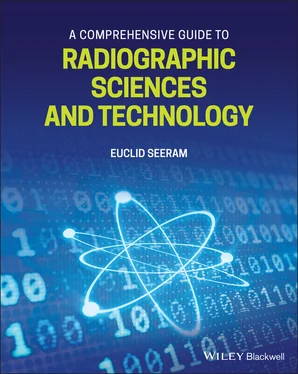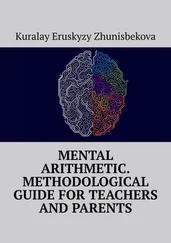Enjoy the pages that follow and remember – your patients will benefit from your wisdom.
Euclid Seeram, PhD., MSc., BSc., FCAMRTBritish Columbia, Canada
It is always a pleasure to acknowledge the contributions of experts in the field of radiographic sciences including radiologic physics, equipment, image quality, quality control, radiobiology and radiation protection from whom I have learned a great deal that allows me to write this book.
First, I am indeed grateful to all those who have dedicated their energies in providing several comprehensive volumes on radiologic physics and instrumentation for the radiologic community. I would like to acknowledge the notable medical physicist, Dr. Stewart Bushong ScD, FAAPM, FACR and experimental radiobiologist, Dr. Elizabeth Travis, PhD. I have learned a great deal on radiologic science from the works of Dr. Bushong, a professor of radiologic science in the Department of Radiology, Baylor College of Medicine, Houston, TX. In addition, I have gained further insight into the nature, scope, and depth of radiobiology and particularly its significance in radiology, from Dr. Travis, a researcher in the Department of Experimental Radiotherapy, University of Texas, MD Anderson Cancer Center, Houston, TX.
Secondly, I am grateful to physicist, Dr. Hans Swan, PhD and digital radiography expert, Dr. Rob Davidson, PhD, who served as my primary supervisors for my PhD dissertation entitled Optimization of the Exposure Indicator of a Computed Radiography Imaging System as a Radiation Dose Management Strategy . Furthermore, Dr. Stewart Bushong served as an external examiner for my PhD dissertation. Additionally, two other notable medical physicists from whom I have learned my digital radiography imaging physics and technology are Dr. Charles Willis, PhD (University of Texas; MD Anderson Cancer Center‐Retired) and Dr. Anthony Seibert, PhD (University of California at Davis). Dr. Seibert's notable textbook on The Essential Physics of Medical Imaging has educated me in the core principles of medical imaging physics. Thanks to you all.
I must acknowledge all others, such as the authors whose papers I have cited and referenced in this book, thank you for your significant contributions to radiographic sciences knowledge base. Additionally, I would like to express my sincere thanks to Dr. Perry Sprawls, PhD, FACR, FAAPM, FIOMP, Distinguished Emeritus Professor, Emory University, Director, Sprawls Educational Foundation, http://www.sprawls.org, Co‐Director, College on Medical Physics, ICTP, Trieste, Italy, and Co‐Editor, Medical Physics International, http://www.mpijournal.org/.
Dr. Sprawls has always supported my writing and I appreciate his free resources on the World Wide Web (www) from which students, technologists, and educators alike can benefit. I must also mention Dr. Anthony Wolbarst, PhD, Medical Physics Department, University of Kentucky (Retired).
Another individual to whom I owe a good deal of thanks is Valentina Al Hamouche, MRT(R), MSc, who is the CEO/Founder VCA Education Solutions for Health Professionals http://www.VCAeducation.ca. Valentina has provided me with opportunities to provide radiographic sciences and CT physics and Instrumentation in‐house lectures and webinars to further educate technologists and students across Canada and internationally. Thanks Valentina.
I must acknowledge James Watson, Commissioning Editor, Wiley, Oxford, UK, who understood and evaluated the need for this book. Additionally, I am grateful to Anupama Sreekanth, former project editor and current managing editor Anne Hunt at Wiley, for the advice and support you both provided to me during the writing stage of this book. Furthermore, I appreciate the work of Sandeep Kumar, Content Refinement Specialist at Wiley, who has done an excellent job in bringing this manuscript to fruition.
Finally, I am very grateful for the warm and wonderful support of my family: my lovely wife, Trish, a very wise and caring person; and my very smart son, David, a very special young man and the best Dad in the universe. Thank you both for your unending love, support, and encouragement.
Last, but not least, I want to express my gratitude to all the students in my radiographic sciences classes – your questions have provided me with a further insight into teaching this important subject. Thank you.
SECTION 1 Introduction
1 Radiographic sciences and technology: an overview
RADIOGRAPHIC IMAGING SYSTEMS: MAJOR MODALITIES AND COMPONENTS
RADIOGRAPHIC PHYSICS AND TECHNOLOGY
Essential physics of diagnostic imaging
Digital radiographic imaging modalities
Radiographic exposure technique
Image quality considerations
Computed tomography – physics and instrumentation
Quality control
Imaging informatics at a glance
RADIATION PROTECTION AND DOSE OPTIMIZATION
Radiobiology
Radiation protection in diagnostic radiography
Technical factors affecting dose in radiographic imaging
Radiation protection regulations
Optimization of radiation protection
Bibliography
Radiographic Science and Technology have evolved through the years, ever since the discovery and use of x‐rays in 1895. This evolution has resulted in the introduction of physical principles and technology with the major goal of improving the care and management of the patient. Furthermore, a significant benefit of these innovations is focused on reducing the radiation dose to the patient without compromising image quality. Radiographic sciences deal with the physics of various diagnostic imaging modalities (radiography, fluoroscopy, mammography, and computed tomography [CT]) and include x‐ray generation, x‐ray production, x‐ray emission, and x‐ray interaction with tissues. Furthermore, radiographic sciences also address radiation risks and radiation protection. Radiographic technology, on the other hand, addresses the equipment components and how they function to produce diagnostic images, image quality characteristics, and quality control (QC) aspects of these imaging modalities.
The workhorse of radiology has been film‐screen radiography which is now obsolete and has been replaced globally with digital imaging . The scope of digital imaging is extremely wide and now involves a basic understanding of computer sciences, to explain how the new digital imaging modalities work. These modalities include computed radiography (CR), flat‐panel digital radiography (FPDR), digital fluoroscopy (DF), digital mammography (DM), digital tomosynthesis, and CT. In addition, the digital imaging environment now demands that operators understand what has been referred to as “imaging informatics,” an area of study that involves picture archiving and communication systems (PACS), enterprise imaging, Big Data, machine learning (ML), deep learning (DL), and artificial intelligence (AI).
With the above in mind, various professional organizations such as the American Society of Radiologic Technologists (ASRT), the Canadian Association of Medical Radiation Technologists (CAMRT), and other professional medical imaging organizations throughout the world have prescribed curricula for diagnostic imaging programs which provide guiding, principles that assist academic program leaders in designing foundational learning outcomes that are intended to meet the professional standards, and more importantly meet the entry requirements for clinical practice. Institutions offering educational programs in diagnostic imaging should be then able to raise the level of these foundational learning outcomes and content to meet the requirements of degree programs, including graduate degree programs in diagnostic imaging.
Читать дальше











